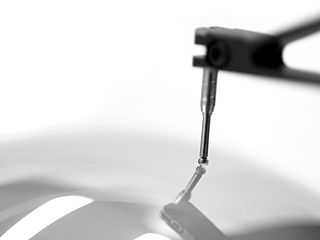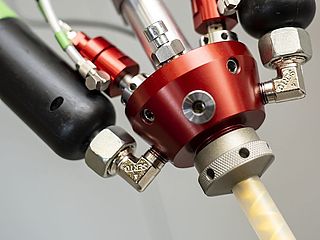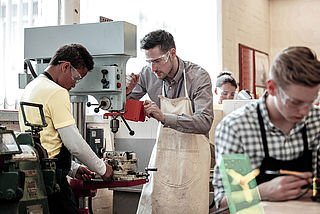Nanotechnology: Researching, developing and making it usable

Nanoscience is considered a key technology of the 21st century. However, in order for it to fully develop its potential, it must first be transformed into nanotechnology. The Karlsruhe Institute of Technology (KIT) plays a decisive role on this path: In the Cluster of Excellence "3D Designer Materials", visions of scalable, digital 3D additive manufacturing techniques are becoming reality. The scientists at KIT aim to research and develop novel tools and processes for this purpose and to optimize process speed and resolution.
At the Nanostructure Service Laboratory (NSL), smallest structures in the micrometer or submicrometer range are primarily investigated. "In their research, our undergraduate and graduate students produce 3D assemblies from various polymers via 3D printing. In the process, they examine their surfaces in terms of roughness and other characteristics," explains Professor Dr. Gernot Goll, head of the NSL. "In this way, we conduct basic research for 3D optical devices, molecularly functionalizable 3D scaffold structures and many other areas of application."

Providing the right tools
The Karlsruhe Institute of Technology (KIT), which includes the NSL, is part of the excellence strategy of the federal and state governments in German higher education. It houses a comprehensive technological infrastructure for the fabrication and analysis of nanostructures. In this way, it supports researchers with a diverse portfolio of competencies from very different fields – for example, in the 3D additive manufacturing techniques mentioned above, or in the field of quantum information technologies, where the development of qubits, the elementary units of a quantum computer, is being intensively pursued. Researchers here have access to state-of-the-art equipment that can be used to develop and optimize production methods. These include, for example, electron beam lithographs, scanning electron microscopes or high-resolution 3D printers.
Surface 3D measurement with the MarSurf CM explorer
ne of the latest additions to the NSL is the MarSurf CM explorer, which has been expanding the range of metrology in the "Carl Zeiss Foundation 3D Additive Manufacturing User Lab" affiliated with the NSL since the end of 2020. With this high-resolution confocal microscope from Mahr, surfaces can be measured and analyzed three-dimensionally – contact-free, material-independent and fast. The measuring deviceprovides 3D measurement values in just a few functional steps.
"Other working groups had recommended the CM explorer to us many times," explains Goll. As a result, he says, they contacted manufacturer Mahr and had the device demonstrated to them at an on-site appointment. Christopher Wallmann, Field Sales Engineer at Mahr, explained the confocal microscope and its many functions to the Karlsruhe researchers. According to Goll, the device was particularly convincing due to the many evaluation options for analysis.

Correct and reproducible measurements
he students and doctoral candidates first receive instruction on the device so that they can then use it independently. As Goll points out, the MarSurf CM explorer clearly meets the requirements that the lab had set for itself: the confocal microscope enables material-independent measurements of any geometries and surface properties, regardless of whether they are specular, absorbent, opaque or transparent. "The MarSurf CM explorer stands for high measurement speed and has a 16-bit HDR function as well as an HD stitching function, i.e. for a constantly high resolution even with large measurement areas," Wallmann explains.
In Karlsruhe, meanwhile, research and realization of functional nanostructures are making promising progress. With state-of-the-art equipment, KIT could even succeed in turning the Upper Rhine Valley around Karlsruhe into an internationally renowned "Nano Valley" analogous to Silicon Valley. At least, this is the declared goal that KIT has set itself within the framework of the Excellence Initiative.
Typical measurement tasks of the MarSurf CM explorer:
- Roughness measurements according to ISO 4287 & ISO 13565 / ISO 25178
- Topography measurements (including volume, wear, tribology)
- Contour and shape (2D, 3D)
- Pore and particle analysis
- Defect analysis
- and much more



















